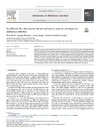Please use this identifier to cite or link to this item:
https://accedacris.ulpgc.es/jspui/handle/10553/55761
| DC Field | Value | Language |
|---|---|---|
| dc.contributor.author | Warsi, Firoz | en_US |
| dc.contributor.author | Khanam, Ruqaiya | en_US |
| dc.contributor.author | Kamya, Suraj | en_US |
| dc.contributor.author | Suárez Araujo, Carmen Paz | en_US |
| dc.date.accessioned | 2019-06-11T12:59:48Z | - |
| dc.date.available | 2019-06-11T12:59:48Z | - |
| dc.date.issued | 2019 | en_US |
| dc.identifier.issn | 2352-9148 | en_US |
| dc.identifier.uri | https://accedacris.ulpgc.es/handle/10553/55761 | - |
| dc.description.abstract | Malignant melanoma is the deadliest form of skin cancer, but can be more readily treated successfully if detected in its early stages. Due to the increasing incidence of melanoma, research in the field of autonomous melanoma detection has accelerated. In this paper, a new method for feature extraction from dermoscopic images, termed multi-direction 3D color-texture feature (CTF), is proposed, and detection is performed using a back propagation multilayer neural network (NN) classifier. The proposed method is tested on the PH 2 dataset (publicly available) in terms of accuracy, sensitivity, and specificity. The extracted combined CTF is fairly discriminative. When it is input and tested in a neural network classifier that is provided, encouraging results are obtained, i.e. accuracy = 97.5%, sensitivity = 98.1% and specificity = 93.84%. Comparative result analyses with other methods are also discussed, and the results are also improved over benchmarking results for the PH2 dataset. | en_US |
| dc.language | eng | en_US |
| dc.relation.ispartof | Informatics in Medicine Unlocked | en_US |
| dc.source | Informatics in Medicine Unlocked [ISSN 2352-9148], v. 17 (2019), 100176 | en_US |
| dc.subject | 120304 Inteligencia artificial | en_US |
| dc.subject | 32 Ciencias médicas | en_US |
| dc.subject | 220990 Tratamiento digital. Imágenes | en_US |
| dc.subject.other | Melanoma | en_US |
| dc.subject.other | Color texturefeature | en_US |
| dc.subject.other | Dermoscopic image | en_US |
| dc.subject.other | Neural network classifier and skin cancer | en_US |
| dc.title | An efficient 3D color-texture feature and neural network technique for melanoma detection | en_US |
| dc.type | info:eu-repo/semantics/article | en_US |
| dc.type | Article | es |
| dc.identifier.doi | 10.1016/j.imu.2019.100176 | |
| dc.identifier.scopus | 85064884216 | |
| dc.contributor.orcid | #NODATA# | - |
| dc.contributor.orcid | #NODATA# | - |
| dc.contributor.orcid | #NODATA# | - |
| dc.contributor.orcid | #NODATA# | - |
| dc.contributor.authorscopusid | 57208467728 | |
| dc.contributor.authorscopusid | 56785943200 | |
| dc.contributor.authorscopusid | 56126551300 | |
| dc.contributor.authorscopusid | 6603605708 | |
| dc.description.firstpage | 100176 | - |
| dc.investigacion | Ingeniería y Arquitectura | en_US |
| dc.type2 | Artículo | en_US |
| dc.utils.revision | Sí | en_US |
| dc.identifier.ulpgc | Sí | es |
| dc.description.sjr | 0,363 | |
| dc.description.sjrq | Q3 | |
| item.grantfulltext | open | - |
| item.fulltext | Con texto completo | - |
| crisitem.author.dept | GIR IUCES: Computación inteligente, percepción y big data | - |
| crisitem.author.dept | IU de Cibernética, Empresa y Sociedad (IUCES) | - |
| crisitem.author.dept | Departamento de Informática y Sistemas | - |
| crisitem.author.orcid | 0000-0002-8826-0899 | - |
| crisitem.author.parentorg | IU de Cibernética, Empresa y Sociedad (IUCES) | - |
| crisitem.author.fullName | Suárez Araujo, Carmen Paz | - |
| Appears in Collections: | Artículos | |
SCOPUSTM
Citations
44
checked on Jun 8, 2025
Page view(s)
211
checked on Sep 27, 2025
Download(s)
239
checked on Sep 27, 2025
Google ScholarTM
Check
Altmetric
Share
Export metadata
Items in accedaCRIS are protected by copyright, with all rights reserved, unless otherwise indicated.
